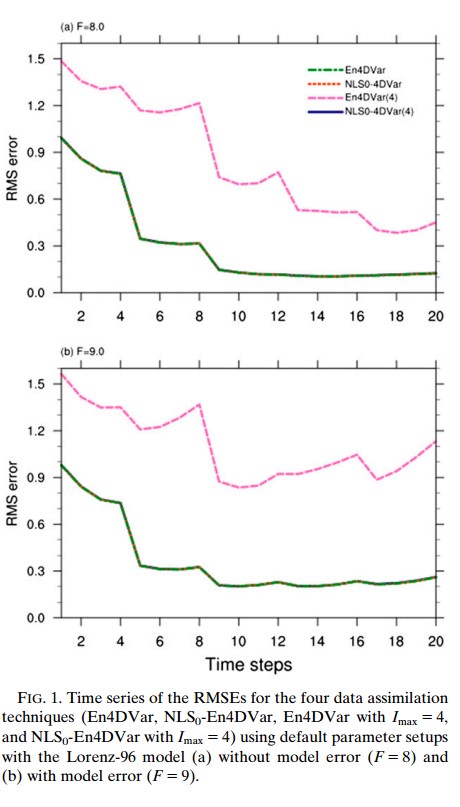最新科研进展
Nonlinear Least Squares En4DVar to 4DEnVar Methods for Data Assimilation: Formulation, Analysis, and Preliminary Evaluation
Authors:
XIANGJUN TIAN1, HONGQIN ZHANG1, XIAOBING FENG2, YUANFU XIE3
1 ICCES, Institute of Atmospheric Physics, Chinese Academy of Sciences, and University of Chinese Academy of Sciences, Beijing, China
2 Department of Mathematics, University of Tennessee, Knoxville, Tennessee
3 NOAA / Earth System Research Laboratory, Boulder, Colorado
Abstract:
The En4DVar method is designed to combine the flow-dependent statistical covariance information of EnKF into the traditional 4DVar method. However, the En4DVar method is still hampered by its strong dependence on the adjoint model of the underlying forecast model and by its complexity, maintenance requirements, and the high cost of computer implementation and simulation. The primary goal of this paper is to propose an alternative approach to overcome the main difficulty of the En4DVar method caused by the use of adjoint models. The proposed approach, the nonlinear least squares En4DVar (NLS-En4DVar) method, begins with rewriting the standard En4DVar formulation into a nonlinear least squares problem, which is followed by solving the resulting NLS problem by a Gauss–Newton iterative method. To reduce the computational and implementation complexity of the proposed NLS-En4DVar method, a few variants of the new method are proposed; these modifications make the model cheaper and easier to use than the full NLS-En4DVar method at the expense of reduced accuracy. Furthermore, an improved iterative method based on the comprehensive analysis on the above NLSi-En4DVar family of methods is also proposed. These proposed NLSi-En4DVar methods provide more flexible choices of the computational capabilities for the broader and more realistic data assimilation problems arising from various applications. The pros and cons of the proposed NLSi-En4DVar family of methods are further examined in the paper and their relationships and performance are also evaluated by several sets of numerical experiments based on the Lorenz-96 model and the Advanced Research WRF (ARW) Model, respectively.

Citation:
Tian, X. H.Q.Zhang, X.Feng, Y.Xie (2017), Nonlinear Least Squares En4DVar to 4DEnVar Methods for Data Assimilation: Formulation, Analysis and Preliminary Evaluation, Mon. Wea. Rev.,
https://doi.org/10.1175/MWR-D-17-0050.1.
